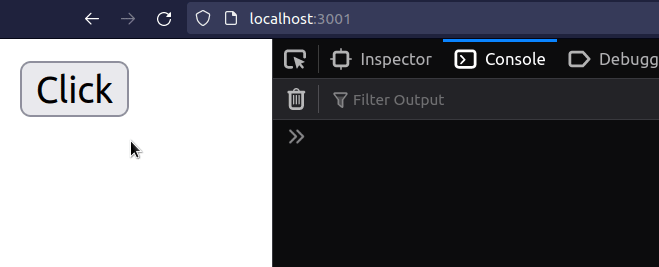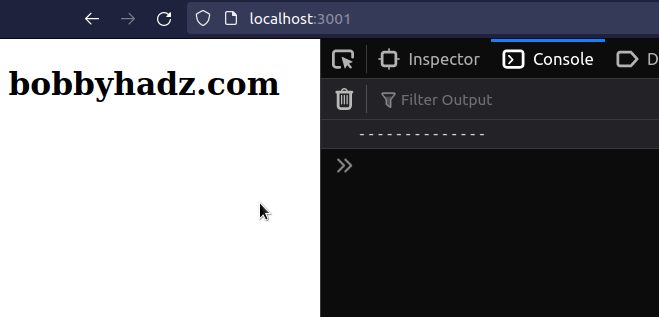Using addEventListener in Function components in React
Last updated: Apr 7, 2024
Reading time·4 min

# Table of Contents
- Using addEventListener in Function components in React
- Adding an event listener to the Window object in a React component
- Add an Event listener to the Body element in React
# Using addEventListener in Function components in React
To use the addEventListener method in function components in React:
- Set the
refprop on the element. - Use the
currentproperty on the ref to get access to the element. - Add the event listener in the
useEffecthook.
import {useRef, useEffect} from 'react'; const App = () => { const ref = useRef(null); useEffect(() => { const handleClick = event => { console.log('Button clicked'); console.log('bobbyhadz.com'); }; const element = ref.current; element.addEventListener('click', handleClick); return () => { element.removeEventListener('click', handleClick); }; }, []); return ( <div> <button ref={ref}>Click</button> </div> ); }; export default App;

We added an event listener to an element in the useEffect hook of a component
using a ref.
window, or document objects, use the same approach excluding the ref.The useRef() hook can be passed an initial value as an argument.
const ref = useRef(null);
The hook returns a mutable ref object whose .current property is initialized
to the passed argument.
current property on the ref object to get access to the button element on which we set the ref prop.useEffect(() => { const handleClick = event => { console.log('Button clicked'); }; // 👇️ accessing .current property const element = ref.current; element.addEventListener('click', handleClick); return () => { element.removeEventListener('click', handleClick); }; }, []);
When we pass a ref prop to an element, e.g. <div ref={myRef} />, React sets
the .current property of the ref object to the corresponding DOM node.
We passed an empty dependencies array to the useEffect hook, so it's only going to run when the component mounts.
We only want to call the addEventListener method once - when the component
mounts.
useEffect(() => { const handleClick = event => { console.log('Button clicked'); }; const element = ref.current; element.addEventListener('click', handleClick); return () => { element.removeEventListener('click', handleClick); }; }, []);
We stored a reference to the element in a variable and used the
addEventListener
method to add a click event listener to the button.
The function we returned from the useEffect hook is called when the component
unmounts.
return () => { element.removeEventListener('click', handleClick); };
We used the removeEventListener method to remove the event listener that we previously registered.
The cleanup step is important because we want to make sure we don't have any memory leaks in our application.
# Adding an event listener to the Window object in a React component
The same approach can be used to add an event listener to the window object.
import {useEffect} from 'react'; const App = () => { useEffect(() => { const handleClick = event => { console.log('Window clicked'); console.log('--------------'); }; window.addEventListener('click', handleClick); return () => { window.removeEventListener('click', handleClick); }; }, []); return ( <div> <h2>bobbyhadz.com</h2> </div> ); }; export default App;

When adding an event listener to the window object, we don't have to use a
ref.
Every time the user clicks on the window, the handleClick function is invoked.
When the component unmounts, the cleanup function runs and removes the event listener.
return () => { window.removeEventListener('click', handleClick); };
If you need to get the window's width and height, click on the following article.
# Add an Event listener to the Body element in React
To add an event listener to the body element:
- Access the
bodyelement on thedocumentobject. - Use the
addEventListener()method on thebodyelement in theuseEffecthook. - Remove the event listener when the component unmounts.
import {useEffect} from 'react'; export default function App() { useEffect(() => { function handleClick() { console.log('click event triggered'); } // 👇️ optionally set body height to full screen document.body.style.minHeight = '100vh'; document.body.addEventListener('click', handleClick); return () => { // 👇️ remove event listener when the component unmounts document.body.removeEventListener('click', handleClick); }; }, []); return ( <div> <h2>Hello world</h2> </div> ); }

We can access the body element on the document object.
We passed an empty dependencies array to the useEffect hook because we only want to add the event listener to the body element once - when the component mounts.
useEffect(() => { function handleClick() { console.log('click event triggered'); } document.body.style.minHeight = '100vh'; document.body.addEventListener('click', handleClick); return () => { document.body.removeEventListener('click', handleClick); }; }, []);
The example shows how to add a click event listener but this approach would
work for any other event type.
The first parameter the addEventListener() method takes is the type of event to listen for and the second is a function that gets invoked when an event of the specified type occurs.
In the example, we set the minHeight CSS property to 100vh to make the body
element full height.
I usually do this in my index.css file.
body { min-height: 100vh; }
Make sure to import your index.css file in your index.js file.
import './index.css'
The function we returned from the useEffect hook is called when the component
unmounts.
return () => { document.body.removeEventListener('click', handleClick); };
We used the removeEventListener() method to remove the event listener that we previously registered.
The cleanup step is important because we want to make sure we don't have any memory leaks in our application.
The same approach can be used to add a class or styles to the body element.
If you need to add or remove a class on click, check out the following tutorial.
# Additional Resources
You can learn more about the related topics by checking out the following tutorials:
- How to Remove an Event listener in React
- Pass event and parameter onClick in React
- Handling onKeyDown event on Div elements in React
- Handle the onPaste event in React (with examples)
- Handle the onScroll event in React (with examples)
- Handle the onChange event on a Select element in React
- Handle double-click events in React

